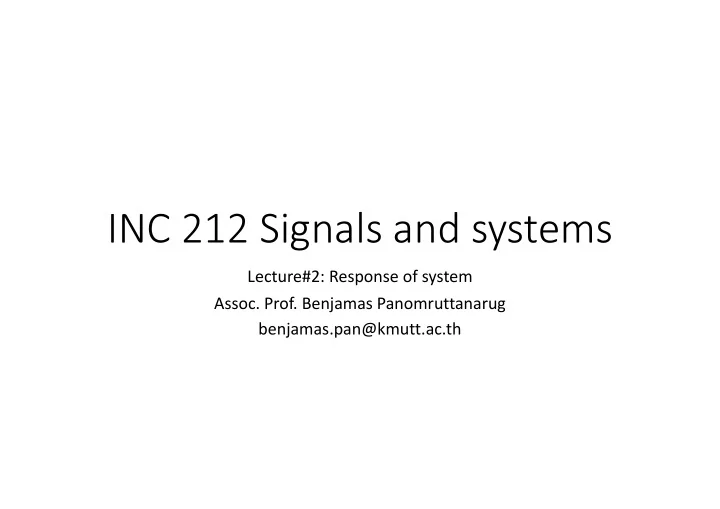

INC 212 Signals and systems Lecture#2: Response of system Assoc. Prof. Benjamas Panomruttanarug benjamas.pan@kmutt.ac.th
Response of a system
Impulse response: h(t) ( ) 0 for 0 t t ( ) 1 t dt
Step response: s(t) 1, 0 t ( ) u t 0, 0 t
Relationship bt. Impulse response and step response d ( ) ( ) h t s t dt
St Step ep Re Response • The step response is defined as the output due to a unit step input signal • Can be solved by using convolution integral (next time) • Can be solved by solving the differential equation 6 BP INC212
Solving differential equation Complete solution: y = y ( h ) + y ( p ) y ( h ) = homogeneous solution, y ( p ) = particular solution = natural response = forced response 7 BP INC212
Exam Ex ample ple 2.7 2.7 RC Cir Circuit uit Output Output Assume that the initial output, y(0) = 1. Show that the impulse response of this circuit is h ( t ) = e t u ( t ). 1 t ( ) ( ) h t e RC u t RC 8 BP INC212
Ex Exam ample ple 2.14 2.14 RC Cir Circuit: uit: St Step ep Respo sponse se 1 t ( ) ( ) The impulse response of the RC circuit h t e RC u t RC Find the step response of the circuit. 9 BP INC212
Solving differential equation d Diffential equation: y t RC y t x t dt d Homogeneous Eq: 0 y t RC y t dt t Homogeneous solution: h V RC y t c e 1 Particular solution: y(t) = k=1 Total solution: y(t) = c 1 e ( ‐ t/RC )+1 , giving the initial condition y(0)=0 10 BP INC212
Ex Exam ample ple 2.22 2.22 RC Circuit (continued): Complete Response Find the complete response of the RC circuit to an input x ( t ) = cos( t ) u ( t ) V, assuming normalized values R = 1 and C = 1 F and assuming that the initial voltage across the capacitor is y(0 ) = 2 V. 11 BP INC212
t 1. Homogeneous sol.: h V y t ce RC 0 = 1 1 RC 2. Particular solution: p cos sin V y t t t 2 2 1 1 RC RC 1 1 R = 1 , C = 1 F 3. Complete solution: t cos sin V y t ce t t 2 2 4. Coefficient c 1 determined by I.C.: 1 1 1 0 2 cos0 sin 0 ce c c = 3/2 2 2 2 3 1 1 5. Final solution: cos sin V t y t e t t 2 2 2 12 BP INC212
Matlab: impulse input Differential Equation: ( ) dy t ( ) ( ) RC y t x t dt • function dy = rc(t,y) • R = 1; C = 1; • x = 0; • dy = (x ‐ y)/(R*C); • %%%%%%%%%%%%%%%%%%%%%%%%%%%%%%%%%%%%%% • t = 0:0.01:10; • R = 1; C = 1; h = impulse([1],[R*C 1],t); • [T,y] = ode45(@rc,t,1); • yt = exp( ‐ t/(R*C)); • figure;plot(T,y,'b',T,yt,'r ‐‐ ‘);
Matlab: unit step input Differential Equation: ( ) dy t ( ) ( ) RC y t x t dt • function dy = rc(t,y) • R = 1; C = 1; • x = 1; • dy = (x ‐ y)/(R*C); • %%%%%%%%%%%%%%%%%%%%%%%%%%%%%%%%%%%%%% • t = 0:0.01:10; • R = 1; C = 1; • s = step([1],[R*C 1],t); [T,y] = ode45(@rc,t,0); • yt = ‐ exp( ‐ t/(R*C))+1; • x = ones(size(y)); • figure;plot(T,y,'b',T,yt,'r ‐‐ ',T,x,'g:')
Matlab: unit step input 1 y 0.9 yt input 0.8 0.7 0.6 y(t) 0.5 0.4 0.3 0.2 0.1 0 0 2 4 6 8 10 Time (sec)
Matlab: sinusoidal input Differential Equation: ( ) dy t ( ) ( ) RC y t x t dt • function dy = rc(t,y) • R = 1; C = 1; • x = cos(t); • dy = (x ‐ y)/(R*C); • %%%%%%%%%%%%%%%%%%%%%%%%%%%%%%%%%%%%%% • t = 0:0.01:50; • R = 1; C = 1; • [T,y] = ode45(@rc,t,2); • yt = 3/2*exp( ‐ t)+1/2*cos(t)+1/2*sin(t); • x = cos(t); • figure;plot(T,y,'b',T,yt,'r ‐‐ ',T,x,'g:'); • xlabel('Time (sec)'); ylabel('y(t)');
Matlab: sinusoidal input 2 y yt input 1.5 1 y(t) 0.5 0 -0.5 -1 0 10 20 30 40 50 Time (sec)
Recommend
More recommend